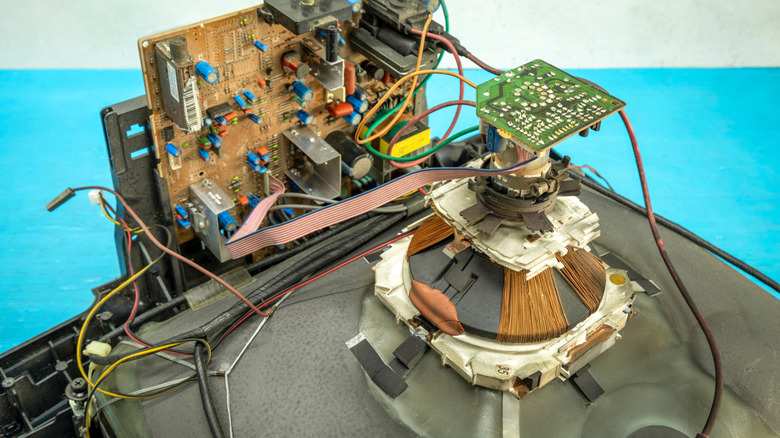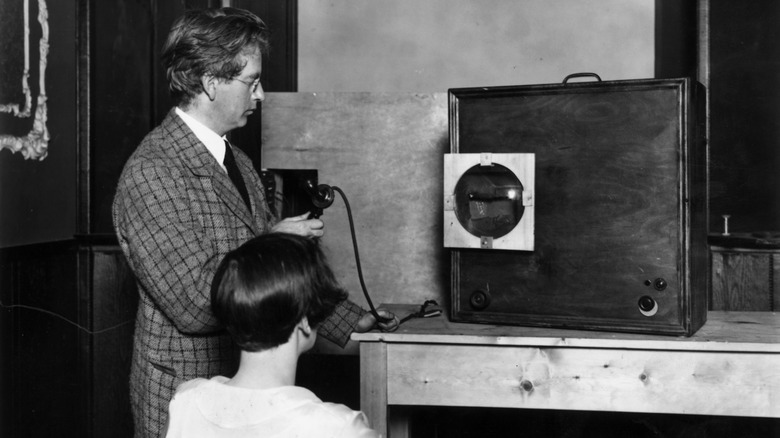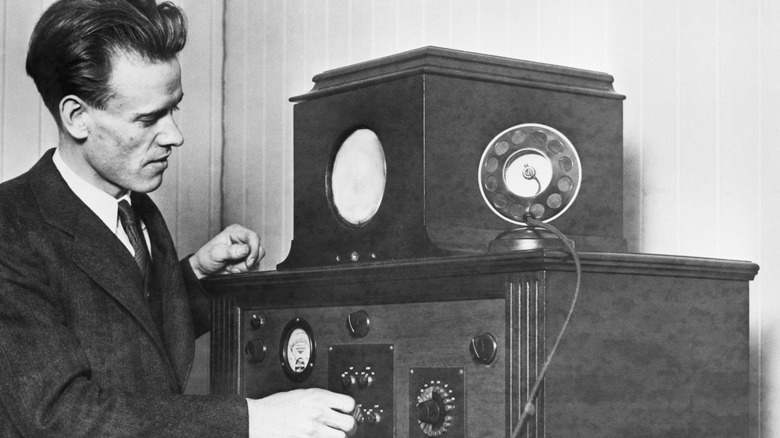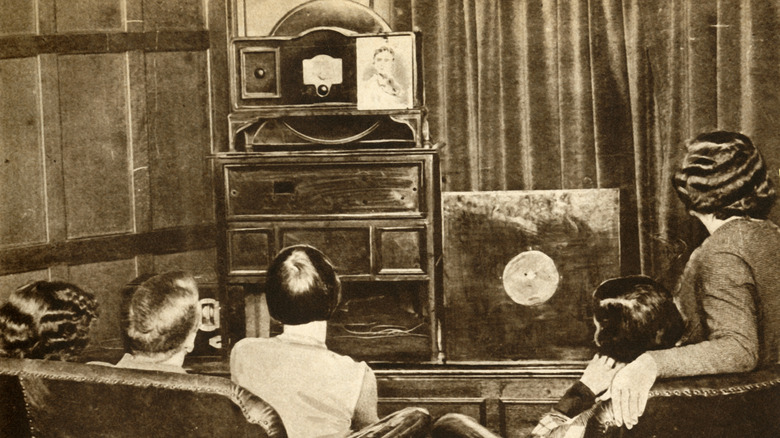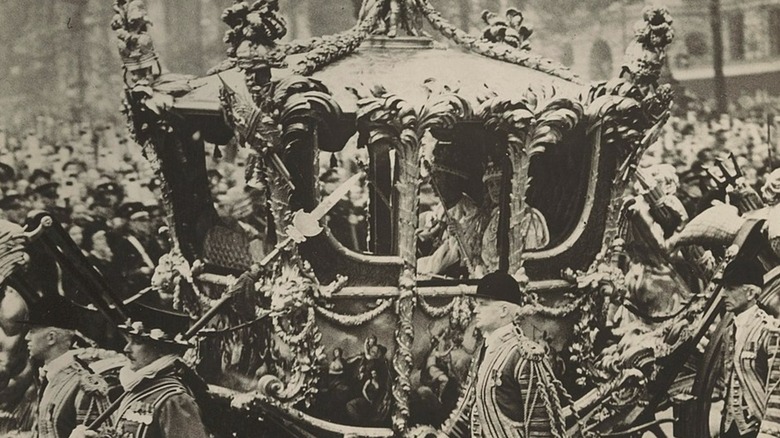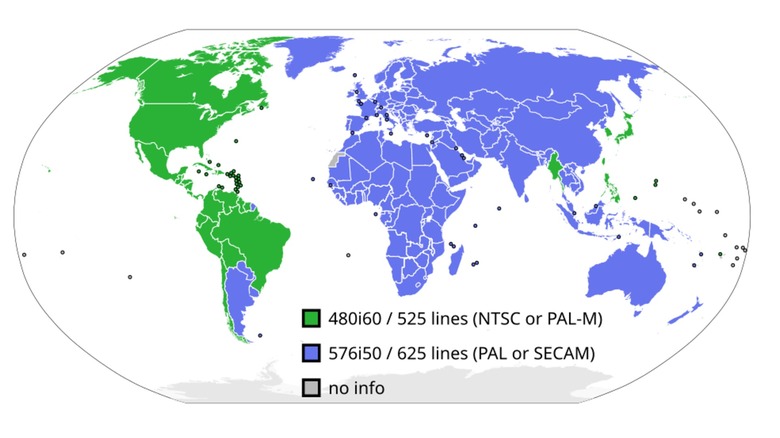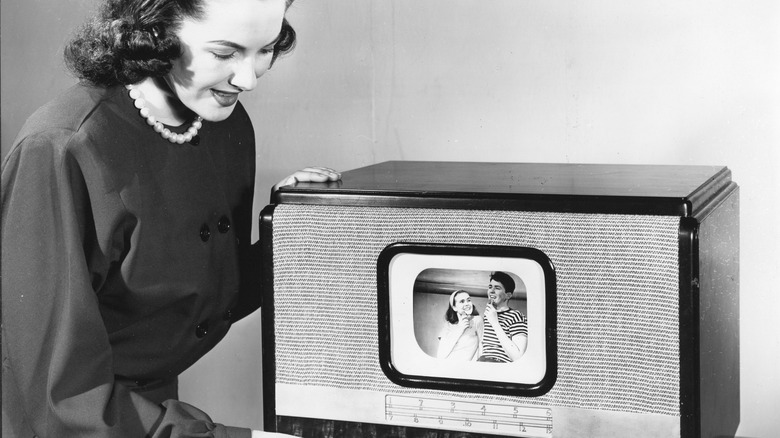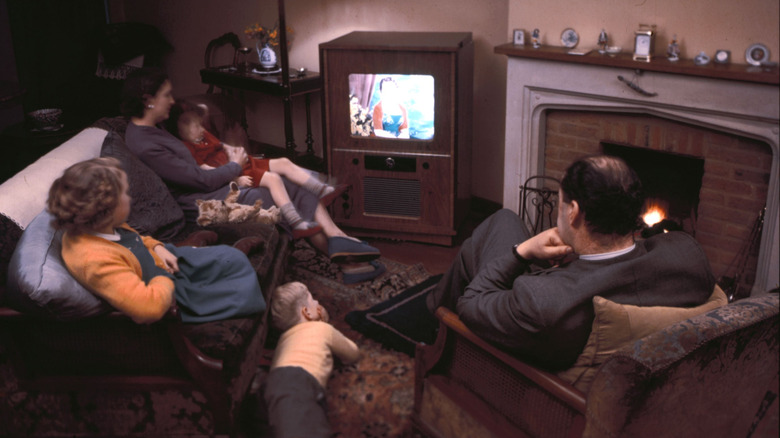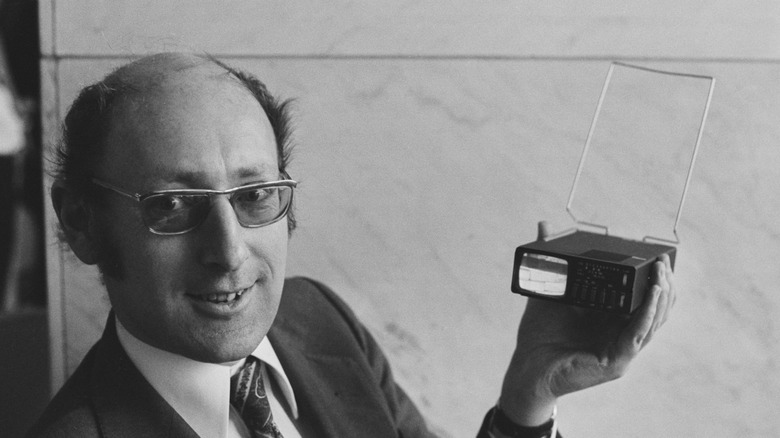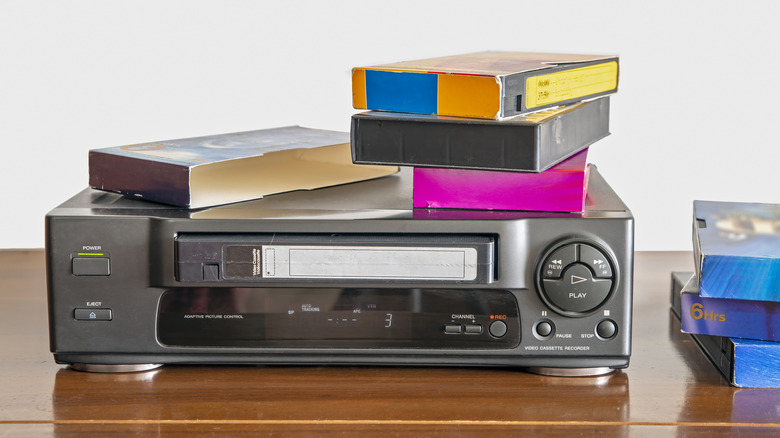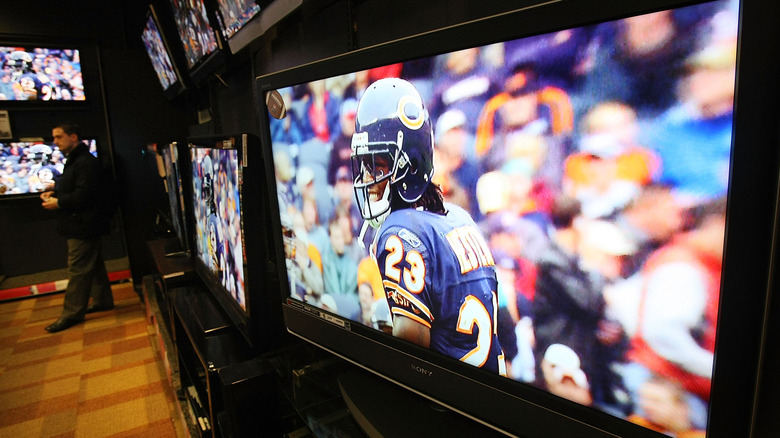13 Of The Most Important Advancements In TV History
Television has become a permanent fixture of modern American life. Nielsen's research for 2023-2024 turned up a penetration figure of 97% among U.S. households. With such intense interest in TV, it's not surprising that entire homes are built with this pastime in mind. Many homeowners opt to install home theater systems in their living space (although when doing this it's important to understand some of the common mistakes people make during the install). Countless others look for the best TV they can buy and orient the entire room to face the screen.
And yet, before the 20th century, moving pictures were a figment of the imagination, and people shaped their room layouts according to conversational necessities, and later to tune into radio broadcasts. That all began to change with the first mechanical televisions, visual entertainment devices that transmitted recorded video on a large, mechanical wheel encased within the machine. Less than 100 years later, the world has adopted the entertainment medium en masse and all kinds of supplementary industries, video recording and editing technologies, and more have sprung up around this singular paragon of wonder. But the path from then to now is filled with all kinds of interim milestones, and the line has hardly been a straight one. These are some of the most important achievements in the long line of technological triumphs that have made the TV what it is today.
Invention of CRT and mechanical scanner technologies
At its heart, television is a technological process that involves two main functions. First, a TV has to take a signal input and create a picture from it. Next, the device must be able to actually produce the visual image for viewers to take in. These two problems were solved independently, although much of the research that early television pioneers were engaged in focused on this pair of technical requirements before and long into the future after their discoveries.
In 1884 Paul Nipkow designed a mechanical scanner that would form the basis of transmission for this visual medium. The Nipkow Scanning Disc was a large metal disc that passed light through a set of holes punctured in its surface. As the disc rotated, the pin holes of light created by its movement would create tiny pictures that could be transmitted as electronic lines, essentially producing data for another technology of early television to pick up and utilize.
That second breakthrough was the cathode-ray tube (CRT). Karl Ferdinand Braun invented this technology in 1897, and modern enthusiasts are still building homemade versions of it today. These tubes would generate visible light when a beam of electrons was fired against its screen. The combination of these pioneering breakthroughs allowed the creation of rudimentary television systems, and sparked a dynamic race to improve upon their early examples. Interestingly, CRT television sets are still in high demand today, with a resurgent marketplace giving them niche importance.
John Logie Baird transmits 30-line television pictures
A World War and quarter century would pass before the next dramatic breakthrough in television technology would be delivered. Routine improvements in the basis of mechanical television machines were continually being developed, but it wasn't until John Logie Baird's "Televisor" machine came into being that TV technology saw its next great leap forward. The Baird Televisor was introduced in 1926 and transmitted a 30-line signal that could handle both sound and moving images (although not at the same time). This device utilized a mechanical scanning disc that was about three feet wide and delivered an image that was roughly the same size as a postage stamp.
1,000 of these machines were produced in total, and the cost was significant, with the £26 price (equivalent to about £2,030 or $2,472 today) leaving only the affluent to consider bringing one into their homes. The Televisor's rollout also enhanced transatlantic communication. In 1928, the first television signal was transmitted across the ocean with the help of a strategically positioned ship mid-route from London to New York.
Electronic television technology is demonstrated
Shortly after Baird's mechanical television completed its transition from project to reality, the electronic television was unveiled, this time in San Francisco. Philo Taylor Farnsworth showcased the electronic TV in 1927, instantaneously launching the medium to new heights. Farnsworth was just a teenager at the time, and discovered that CRT technology could also be used to scan images with electric beams, delivering a rapid visual reproduction, with higher image quality and cheaper production costs. At roughly the same time Kenjiro Takayanagi, a Japanese high school student, also created a working CRT scanner to reproduce electronic television signals.
Farnsworth's invention came to him while plowing fields at just 14. He developed a system whereby a photoelectric surface would capture the brightness patterns of an image, and then an anode would scan the resulting electron image before a separate cathode-ray tube would reproduce the electronically generated result, similar to the process of methodically plowing a field. The future was boundless, even as television technology remained largely in its infancy.
Sound and video are transmitted simultaneously
The 1920s saw tremendous change in technology surrounding the transmission of voice and video. But these advancements were still hindered by one important breakthrough that we take for granted today. It wasn't until the beginning of the 1930s that video was transmitted to television sets at the same time as sound.
Shortly after the Baird Televisor became commercially available in 1929, the British television industry would build a second transmitter. Previously, Televisor units would receive two minutes worth of video signal followed by a two minute offering of accompanying sound. The result was a kind of rudimentary viewing experience that served more as an addition of short video segments to the existing radio signals than a completely new product altogether. But as quickly as the second transmitter was built, dedicated television programming began. The first British television drama quickly followed this capability expansion, and Baird would televise the 1931 Derby the next year.
The 1937 coronation of King George VI
In 1937, the coronation of the new British monarch was presided over by three of the BBC's six cameras. While it wasn't the first to be fully televised (his daughter's coronation 15 years later would claim this title), the spectacle was declared by the British press to be "the supreme triumph of television to date." The BBC's broadcasting operation was just six months old at the time, and the network captured moving images of the newly crowned king smiling as he passed by its setup on his way to Buckingham Palace. The outlet reported that over 10,000 people watched the coronation spectacle, bringing the King's image and voice directly into the homes of Britons for the first time.
This ceremonial procession wasn't the end of television's prominence in social and political life. Indeed, the crowning of a new British king was just the beginning of the technology's capacity to bring important and weighty events into the view of everyday citizens. Critically world changing events would continue to be broadcast over the airwaves in the decades to follow. In 1969, an estimated 650 million people watched Neil Armstrong take his first steps out of the lander and onto our Moon. At the decade's open, John F. Kennedy and Richard Nixon took to the debate stage to participate in America's first televised presidential debate, just a few short years before Kennedy would become the first American president assassinated while appearing live on those very same screens.
The 525-line and 625-line standards are created
Today, much of the TV viewers consume is delivered into their homes via digital signal feeds. But analog television sources were the original input. Once the viewing public got a taste for what television could do, the technology exploded in its ability to reproduce filmed footage for audiences. In 1941, the American standard definition resolution was created and adopted. Much more capable than the original 30-line Baird television technology, this analog signal was based on a 525-line framework and delivered 30 frames per second with 486 lines carrying visible images onto the screen.
Around the same time, the 625-line raster standard was established in the Soviet Union, and adopted as its standard operating process for sending video signals. The image was delivered on 576 visible lines at 25 frames per second in an effort to match the video output characteristics of film. Today, these two analog standards remain the norm among television broadcasting. North and (most of) South America broadcast in the 525-line standard, while Europe, Africa, Asia, and Australia all utilize the 625-line alternative (with the exception of a few countries like Japan and the Philippines).
By 1949, Americans are buying 100,000 televisions per week
The outbreak of World War II halted much of TV's technological progress. It also put a freeze on television programming across much of the broadcasting world. Broadcasts in the U.K. were suspended entirely on the day war was officially declared against Germany. The BBC's transmission equipment was repurposed to jam enemy aircraft signals, and all the manufacturing facilities that had been making television equipment prior to the war shifted focus to produce radio equipment and radar components in service to the war effort.
A similar experience was seen in the United States when it joined the war a few years later. Although television broadcasts weren't entirely shuttered, they were minimized in scale. Similarly, production facilities that had been developing and building new television systems were reimagined to support wartime needs in much the same way as their British contemporaries. Engineers and scientists working on television systems refocused their efforts on developing radar and communication tools and companies like RCA developed camera systems that could be used in remote controlled bombing tools. At the end of the war, things changed dramatically for the television industry.
By 1949, Americans were buying 100,000 television units every week and four networks were prominently offering daily broadcasts for their viewers. ABC, NBC, CBS, and DuMont all put out regularly scheduled programming for the entertainment of the American public, establishing some of the first vestiges of a primetime schedule.
The color TV is unveiled in 1953
Color television was a project many engineers had dreamed of for as long as they were trying to deliver television itself. However, creating a color broadcast proved difficult. A German design to produce color television was developed in 1904 and Vladimir Zworykin, who would eventually work within the RCA universe to bring new television technology to the masses, submitted a patent for his color TV concept in 1925. Neither of these designs ultimately yielded commercially available devices. The stalemate would continue for many years. Perhaps as a result of stalled focus during the war, the establishment of color TV would ultimately come from RCA — working directly with Zworykin — in 1953.
The company worked diligently from 1946 to 1950 researching ways to deliver a broadcast in color. In its own story about the history of television, RCA's Chairman, David Sarnoff notes that it must have spent roughly $70 million working to finally achieve this breakthrough — and in a black and white broadcast, no less. The end result was finally advertised at the end of 1953, and once again television would see a fundamental and dynamic change to the product it was bringing into the homes of viewers.
The 1960s see the arrival of the remote control
Up until this point, much of the technological advancement that television sees lies within the device itself. Color playback, picture quality enhancements, larger screen dimensions, and smaller boxes are all in the works throughout the early days of television. Affordability is also a big goal that television manufacturers seek out in their continuous research processes. These same targets remain vital components in modern television advancements today, even as the product has leapt forward in complexity.
One important change that took place in the 1960s, however, was the introduction of the remote control alongside the RCA Victor TV. Some remote options started appearing in the '50s, but the remote control really became a standard feature with this release. before this point, viewers had to physically get up out of their seats to change the dial. In the same way that modern camera technology in cellphones altered the way a person might "snap" a picture, changing the channel became a much different task that more completely rounded out the life of leisure that a television set brought into the household.
Color TV goes mainstream in the 1970s
In the decade following remote control technology that changed the way viewers operated their television sets, a few important new breakthroughs took place. The Sinclair Microvision, one of the weirdest TVs to hit the market, was released in 1976, bringing a portable television with a tiny form factor to the market for the first time. The result was a novel way to interact with your viewing screen that would carry over into modern television and other video consumption. While still a long way off from the futuristic technology of cellphone devices that allow you to completely carry your entertainment the screen along with you, the novel portability of television meant that viewers were no longer tethered entirely to one specific room in the house.
Another change in the television marketplace that was making big strides in the 1970s was a mainstreaming of color television. Even with the color TV existing in the market for two decades, it didn't become a real option for the wider viewing audience until this time. The last of an era of primarily black and white films were produced in the late '60s. Films like "In Cold Blood" (1967), and "Who's Afraid of Virginia Wolf" (1966) were some of the last to be released during the era of non-color dominance.
VCR technology is introduced
VCR technology was invented in 1956, but it wouldn't rise to prominence until the 1980s. JVC released the VHS videotaping system in 1977, and as a home video resource it quickly became the gold standard in recording and viewing video. The VHS tape made capturing video in just about any setting inexpensive and easy for the masses. Even with the technology predating the VHS system, people growing up in the 80s and 90s will immediately recognize a vintage camcorder and likely feel intense nostalgia when handling the large and small tapes used to document their early lives and record their favorite shows and movies from live broadcasts.
The VCR allowed for easy overwriting as well, so a tape could be used multiple times if necessary. The analog nature of the technology allowed users to easily tape over existing material if they didn't have a blank tape available to record something they wanted to keep. However, as with every technology the VCR would enjoy a magnificent peak and then fall out of favor. In 2003, VHS tapes were officially overtaken by the next iteration of video playback and 2006's "A History of Violence" was the last film produced in the VHS format.
DVDs change how viewers interact with their TVs
What would come to supplant the VHS tape was, of course, the DVD. The Digital Versatile Disc hit the markets in 1996. The first videos formatted onto DVDs were "Blade Runner" and "The Fugitive," released alongside the first DVD players in Japan, while "Twister" was the first DVD commercially available in the U.S. a few months later (in 1997). DVDs provided far greater longevity than VHS tapes. A smudged tape or broken reel could doom a VHS to the trash heap, while routine scratches on a DVD proved harmless. The recording medium was also smaller and far easier to transport than bulky VHS tapes.
DVDs proved exceedingly useful in other ways, too. Viewers could skip ahead to pre-established scenes within a movie, called chapters. They also didn't have to rewind a DVD in order to watch the video again, consigning another common saying to the annals of history in "be kind, rewind."
Flatscreen TVs, HD and Smart TVs, and 3D
In the first decade of the 2000s, a bevy of new technologies were released. Flatscreens were introduced in 2005, immediately changing the way people contemplated their viewing space. Rather than demanding a bulky unit to support the tremendous weight and size of a tube-style television's pronounced back hump, television screens could be mounted on walls or set down on much slimmer pieces of furniture. This meant they could fit in a wider range of locations for improved viewing experiences. Televisions began to grow larger as a result of this change, too.
This kicked a period of rapid development. High definition television came into the homes of consumers as mainstream tech (the first U.S. HD broadcast was in October 1998, with the Space Shuttle Discovery launch). In 2007, the Smart TV made its debut, allowing users to integrate new features directly into the television experience, eventually coming to include virtual assistant tools, as well as voice controls and other accessibility tools. The first movie shot in 3D was also released during this decade ("Avatar" in 2010), and 4K made its debut just two years later in 2012. Today, the 8K resolution standard is just beginning to take shape in the commercial marketplace, begging the question of where we will continue to go on this quest to reach ever increasing heights.

